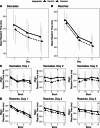Oculomotor learning is evident during implicit motor sequence learning
- PMID: 40108211
- PMCID: PMC11923115
- DOI: 10.1038/s41598-025-93498-0
Oculomotor learning is evident during implicit motor sequence learning
Abstract
Motor sequence learning involves both oculomotor and manual motor systems, yet the role of the oculomotor system in the learning and execution of skilled arm movements remains underexplored. In the current work, the influence of sequence learning on the oculomotor system was investigated by testing 20 healthy adults for 3 days as they practiced an implicit motor learning task, the serial targeting task (STT). The STT contained a repeated sequence, which was interleaved with random sequences. This task was practiced on a KINARM robot that tracked both saccades and reaches. A delayed, 24-h retention test assessed sequence-specific motor learning. Sequence-specific changes across practice and learning were observed for both saccades and reaches; this was demonstrated by faster saccade and arm motor reaction times for the repeated sequence compared to random sequences. Notably, change in the oculomotor system occurred earlier in practice as compared to the manual motor system. Reaches were executed more quickly when led by express saccades (rapid eye movements occurring within 90-120 ms) compared to when they were preceded by regular latency (> 120 ms) saccades early in practice. Our findings highlight distinct yet interconnected functions between oculomotor and manual motor systems associated with implicit motor sequence learning.
Keywords: Implicit motor sequence learning; Motor skill learning; Oculomotor learning; Reaches; Saccades.
© 2025. The Author(s).
Conflict of interest statement
Declarations. Competing interests: The authors declare no competing interests.
Figures





References
-
- Doyon, J., Penhune, V. & Ungerleider, L. G. Distinct contribution of the cortico-striatal and cortico-cerebellar systems to motor skill learning. Neuropsychologia41, 252–262 (2003). - PubMed
-
- Nissen, M. J. & Bullemer, P. Attentional requirements of learning: Evidence from performance measures. Cogn. Psychol.19, 1–32 (1987).
-
- Squire, L. R. Mechanisms of memory. Science232, 1612–1619 (1986). - PubMed
-
- Squire, L. R. Memory and Brain (Oxford University Press, 1987).
MeSH terms
Grants and funding
LinkOut - more resources
Full Text Sources

